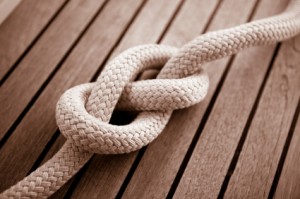There have been countless knots that have been discovered over the years. Many people use knots in their profession—from fishermen to rescue workers, from farmers to rock climbers. What about the average Joe, however, the person that just wants to know a few knots that will get them by in most any situation? How do they decide which knot would be most beneficial?
To Begin With…
The point at which the rope will snap under the strain of the load is called “breaking strength.” According to BoatSafe.com, the safe working load of a rope is considered to be one-fifth its breaking strength and you should never stress a rope anywhere near that limit. Splices, stretching, wear, UV deterioration, and age—these and other factors all affect the safe working load of the rope.

Additionally, knots tend to also lower the strength of rope. Depending on the knot used, you can drop the safe working load down by 40 percent or more. While it’s true that some of the newer ropes have breaking strengths of thousands of pounds or more, that’s not so for those ropes subjected to the above-mentioned factors.
The best knot you can use is one that reduces the breaking strength of the rope as little as possible and is the easiest to remember how to tie. A knot is no good if it’s so convoluted in design that you need an instruction manual to tie it.
If you’re interested in more specific aspects of knot tying, such as knot breaking strengths and theories, you can access the Knot Tyers Guild forum here. (Yes, there is actually a guild of knot tyers. We’re not talking your regular ol’ granny knot here!)
Where to Begin?
Let’s get some basic terminology down first. For instance:
1 ) A loop is when a rope circles around and then crosses over or under itself.
2 ) The working end of the rope is the end that is being looped and twisted. It’s the end most visible in the pictures that follow.
3 ) The standing part is the end that is mostly stationary. It’s the part of the rope that the working end is wrapping around.
4 ) When we say dressing a knot, we’re not talking shirts and pants. This means to make sure that all parts of the knot are where they’re supposed to be and that there’s no unnecessary looping.
5 ) Setting a knot means that it’s tightened before use. If you don’t make sure the knot is tight, it can come loose or fall apart completely. This would be a disaster in most situations. (Think about it—how many couches and mattresses have you seen lying on the side of the road because someone didn’t tie a knot properly?)
Nine Useful Knots
These are the most useful, common knots used by folks. However, there are encyclopedias and diagrams of thousands of more knots that you can find on the internet. The A-Z of Knots is one such site, as is www.iwillknot.com. While some of these knots look alike, you’ll notice that there’s a difference in the way one end loops around another or the way it looks once it’s set.
1 ) Overhand Knot – used as a “stopping” knot.
2 ) Figure Eight Knot – used commonly at the end of a string when tying a package.
3 ) Reef (Square) Knot – used in the UK to shorten the sails on a boat. Ties flat so it doesn’t work loose.
4 ) Sheet (Becket) Bend – used to join two rope ends, especially if they’re of different sizes.
5 ) Carrick Bend – used for joining two very thick ropes.
6 ) Bowline – this knot doesn’t slip or jam, so it’s excellent for using around a person in a rescue, if done properly.
7 ) Clove Hitch – one of the most widely used knots. Very little stress put on the rope fibers with this knot.
8 ) Timber Hitch – used to drag heavy objects.
9 ) Taut-Line Hitch – this knot will hold firmly on a smooth pole, so it’s used often for tent ropes.
Other articles in this issue:
 Off The Grid News Better Ideas For Off The Grid Living
Off The Grid News Better Ideas For Off The Grid Living



